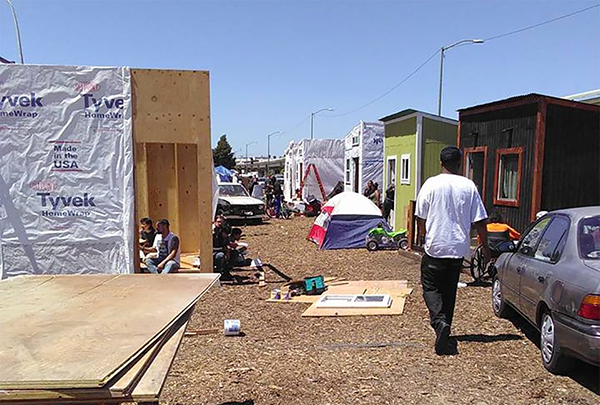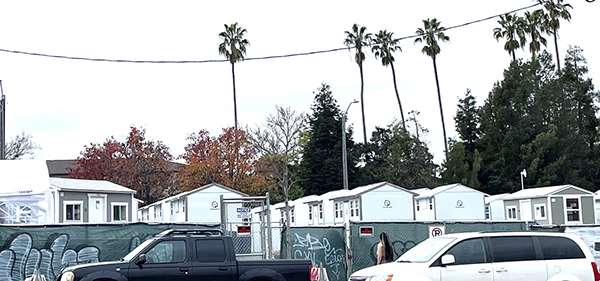
Photo / SFist
OAKLAND, CA — Oakland City Council member Carroll Fife recognizes that residents of a large encampment of unsheltered people in her district are, in fact, her constituents. Fife, who was elected to the council in 2020 and has been homeless herself, is behind an effort to give these residents a piece of public ground and provide small houses, sanitary and cooking facilities, a garden and most importantly, the opportunity to govern themselves, something they had already been doing.
“We will have a say in what’s going to happen,” said Monica Velasquez, who has been homeless since 2016 and lives with her 18-year-old daughter near the new encampment which should receive the 40 new homes and upgraded facilities owned by California’s highway department, Caltrans by this month.
Velasquez and others have already initiated a system of self-governance in the tent and car community where they live.
This project will rely on $3.9 million in unused city funds for the homeless. It will pay for improvements along with supporting a joint management structure between residents and a local non-profit housing developer. The community advisory board will meet regularly with housed neighbors, many of whom are sympathetic but fear loitering and dumping. “We have witnessed first-hand the dumping by housed residents and construction companies. We share a lot of their concerns,” Fife said. “We don’t always agree on every single thing, but they have been supportive.”

Photo / Laura Thomas
The co-governance structure is still being worked but should rely heavily on the rules the community has already adopted, she said.
Fife refers to this initiative as an “intervention” and described the co-governance structure as the “new model for the future of interventions.”
Fife took part in a takeover by two homeless young mothers of an empty investor-owned home in a nearby West Oakland neighborhood that grabbed national headlines in December 2019, highlighting the number of homes that were passing from long-time residents to wealthy newer residents or remaining vacant.
Oakland’s third district, now represented by Fife, encompasses the earliest homes built in Oakland in the 19th century – many gracious, large Victorians. The district later housed the city’s multi-ethnic working class of early 20th century immigrants and became the heart of Oakland’s black community following World War II. But the 21st century boom of technology companies in Silicon Valley to the south has caused massive building of high-rise condos and subsequent displacement in both San Francisco and Oakland. Fife said her district contains the largest number of homeless encampments in the city. In 2019, there were more than 3,200 people on city streets out of a total homeless population of more than 4,000 — a nearly 68% increase from 2017.
Fife is eyeing other parcels around the city that are public land, she said, “to address the housing crisis. County, state and school districts have vacant lots.” Caltrans, in particular owns large tracts all around the state and even abandoned homes, such as the 160 in Pasadena which tenant activists are fighting to claim.
The Oakland encampment is being designed by a local architect and includes cooking, toilet and shower facilities, a yurt for public gatherings, a car port, barbecue pits, and shipping containers for storage. The 8-by-8 foot aluminum cabins are manufactured in Seattle and have heaters and electrical outlets. They have already used by the city at another homeless living site closer to the city’s center.
Making the parcel a “place of beauty” is also important. Two collectives from the neighborhood, City Slicker Farms garden and the Black Artists Guild will aid in starting a garden and painting murals.
Velasquez and her daughter, who works for Elon Musk’s Tesla company in Fremont, say they are looking forward to feeling warm. “It’s hard for her to take a shower,” Velasquez said. “It will give us some stability to get on our feet.”
Another resident active in the community’s governance, Christina Armstrong, also exemplifies the large number of residents who have jobs but can’t afford housing. She, too, works long shifts at Tesla and lives in her car at the site. “I can’t wait to have that little home,” she said.
The co-governed camp concept has been pushed by Oakland’s Housing Advocacy Working Group that issued a set of guidelines for developing a leadership structure and operating procedures last January.
